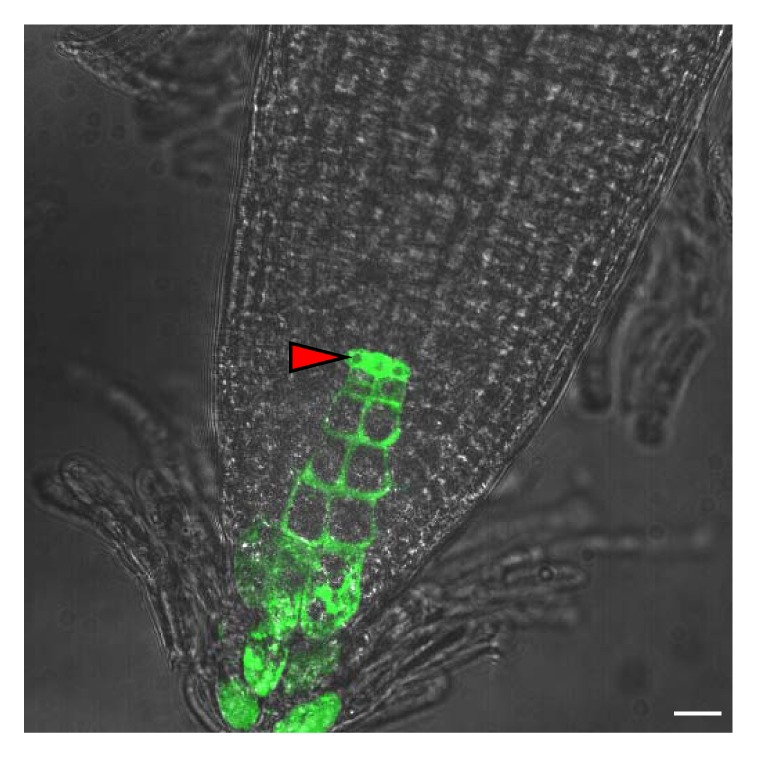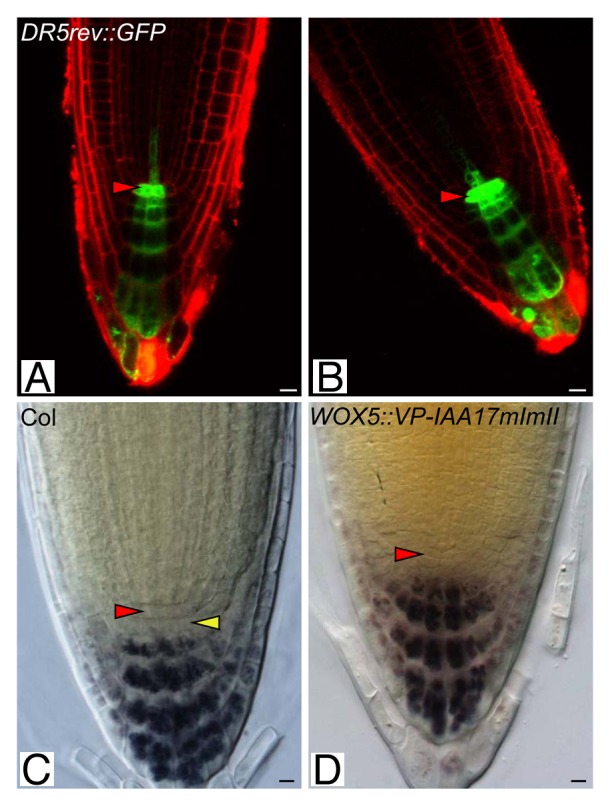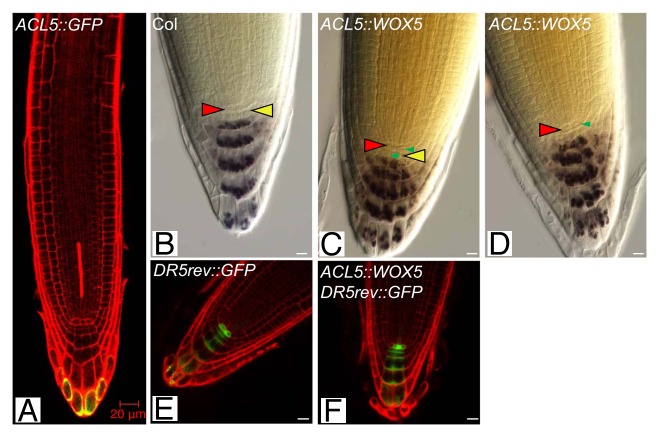Abstract
The plant hormone auxin plays a critical role in the maintenance of root stem cell niches in Arabidopsis. We have recently reported that WUSCHEL-RELATED HOMEOBOX 5 (WOX5) transcription factor modulates free auxin production in the quiescent center (QC) of the root and its expression is inhibited in a feedback-dependent manner by canonical auxin signaling that involves indole-3-acetic acid 17 (IAA17) auxin response repressor. WOX5-IAA17 feedback circuit assures the maintenance of auxin response maximum in the root tip and thereby contributes to the maintenance of distal stem cell (DSC) populations. Here, we provide evidence to show that an optimal auxin maximum in QC guided auxin signaling gradient in root tips is crucial for maintaining root DSC identity.
Keywords: QC, auxin, auxin gradient, auxin maximum, root
The small signaling molecule auxin is a versatile regulator of plant growth and development including root patterning.1-3 In the Arabidopsis root, a gradient-guided auxin maximum is maintained by both polar auxin transport and local auxin biosynthesis. The acropetal and basipetal auxin flows in the root are largely coordinated by PIN proteins that determine the direction of polar auxin transport, and by AUX/LAX auxin influx and PGP/MDR/ABCB auxin efflux carriers.4,5 Besides polar auxin transport, we recently found that the WUSCHEL-RELATED HOMEOBOX 5 (WOX5) transcription factor that is specifically expressed in the quiescent center (QC) is also involved in the establishment of the root-associated auxin maximum via modulating free IAA production.6 This root-associated auxin maximum guides root growth and development by modulating cell division, cell expansion and stem cell differentiation.5,7,8
Previous studies based on the DR5::GUS auxin signaling response reporter suggested that the auxin maximum is mainly located in the root columella cells.7,9 However, direct auxin measurements10 and theoretical predictions11,12 suggested that the highest auxin content should be spatially restricted to the QC. When examining carefully the auxin response in root tips with the alternative DR5rev::GFP reporter, we found that the auxin signaling maximum is indeed in the QC of the root apex, and there is a clear auxin signaling gradient between QC cells and root apex cells below the QC (Fig. 1).

Figure 1. The auxin gradient in the root apex shown by the auxin signaling reporter DR5rev::GFP. The auxin signaling maximum is located into the QC marked with red arrows. The scale bar represents 20 µm.
Our recent investigations showed that locally suppressed auxin signaling in the QC via driving the inactivated version of IAA1713 under the QC-specific WOX5 promoter strongly enhances the root DSC differentiation.6 To determine whether the QC-associated auxin signaling maximum is sufficient to maintain the root DSC identity, we generated WOX5-VP-IAA17mImII lines, which have locally activated auxin signaling in the QC via driving the activated version of IAA1713 under the QC-specific WOX5 promoter for our studies. In these lines, compared with the wild-type control, the DR5rev::GFP signals in the QC were highly increased, whereas the signal in root apex cells below the QC was similar (Fig. 2A and B). Surprisingly, we found that WOX5-VP-IAA17mImII lines also showed highly enhanced root DSC differentiation phenotypes (Fig. 2C-D, 93/109), similar to that in WOX5-HA-IAA17mImII lines, which exhibit the absence of auxin signaling maximum in the root QC.6 Our investigations showed that both increasing and decreasing auxin signaling in the root QC disturb the root DSC maintenance. Therefore, the auxin gradient between QC cells and root apex cells below the QC might be crucial for maintaining the root DSC identity.

Figure 2. Increased auxin signaling maximum in the root QC results in enhanced root DSC differentiation. (A-B) The auxin gradient in root apex, which is shown by auxin signaling reporter DR5rev::GFP. Compared with the wild type control (A), the auxin signaling maximum is strongly increased in WOX5-VP-IAA17mImII lines, which have QC specifically expressed activated version of IAA17 (B). Red arrows represent the auxin maximum in the QC. The scale bar represents 20 µm. (C-D) Differentiation status of root DSCs (yellow arrowhead) below the QC (red arrowhead) in 4-d-old seedlings as inferred from the lugol staining. Wild-type roots show typically 1 tier of root DSCs (C), WOX5-VP-IAA17mImII (D) shows complete root DSC differentiation. The scale bar represents 20 µm.
To confirm this observation, we generated ACL5::WOX5 lines in which WOX5 is ectopically expressed in distal root cap cells under the ACL5 promoter (Fig. 3A), thus possibly altering auxin gradient between the QC and the root apex cells below the QC via WOX5 modulated free IAA production.6 In ACL5::WOX5 lines, the QC and DSC cells in roots are actively dividing (Fig. 3B-D, 62/112) and the root DSC differentiation was enhanced compared with the wild-type control (Fig. 3D, 65/121). Although we couldn’t observe the clear difference in the auxin gradient between QC cells and root apex cells below the QC with DR5rev::GFP as a reporter (Fig. 3E and F), the defective phenotypes of root stem cell niches in ACL5::WOX5 lines might result from the disturbed auxin gradient, which couldn’t be distinguished with DR5rev::GFP as a reporter.
Figure 3. Ectopic expression of WOX5 causes QC division and promotes root DSC differentiations in root tips. (A) ACL5::GFP expression patterns in the root apex. The scale bar represents 20 µm. (B-D) Differentiation status of root DSCs (yellow arrowhead) below the QC (red arrowhead) in 4-d-old seedlings as inferred from the lugol staining. Wild-type roots show typically 1 tier of root DS cells (A), ACL5::WOX5 lines show complete root DSC differentiation (C) or active cell divisions in the QC and root DSCs (B-C). The scale bar represents 20 µm. The green arrows indicate the ectopic cell division in the QC or stem cells. (E-F) The auxin gradient in the root apex which is shown by the auxin signaling reporter DR5rev::GFP. The auxin signaling gradient in ACL5::WOX5 lines (E-F) is not changed compared with the wild-type control (D). The scale bar represents 20 µm.
In summary, our investigations show that either increasing or decreasing auxin signaling in root QC cells will disturb root DSC maintenance, suggesting that an optimal auxin maximum is required in the QC for the maintenance of the root DSC identity. The graded auxin response between QC cells and root apex cells below the QC in root tips is crucial for maintaining the root DSC identity.
Disclosure of Potential Conflicts of Interest
No potential conflicts of interest were disclosed.
Acknowledgments
We acknowledge Tom J. Guilfoyle and Jiri Friml for sharing published materials. We thank Pierre Hilson for helpful comments for this manuscript. This work was supported by the funding from National Natural Science Foundation of China (No. 31222005 and No. 31270327), “Qilu Scholarship” from Shandong University of China and from Ministry of Education (11200081963024,) and “1000-talents Plan” from China for young researchers (11200095551303) to ZD, from the Independent Innovation Foundation of Shandong University, IIFSDU (2011TB012) to HT.
References
- 1.Chapman EJ, Estelle M. Mechanism of auxin-regulated gene expression in plants. Annu Rev Genet. 2009;43:265–85. doi: 10.1146/annurev-genet-102108-134148. [DOI] [PubMed] [Google Scholar]
- 2.Kepinski S, Leyser O. The Arabidopsis F-box protein TIR1 is an auxin receptor. Nature. 2005;435:446–51. doi: 10.1038/nature03542. [DOI] [PubMed] [Google Scholar]
- 3.Dolan L. Pointing roots in the right direction: the role of auxin transport in response to gravity. Genes Dev. 1998;12:2091–5. doi: 10.1101/gad.12.14.2091. [DOI] [PubMed] [Google Scholar]
- 4.Geisler M, Murphy AS. The ABC of auxin transport: the role of p-glycoproteins in plant development. FEBS Lett. 2006;580:1094–102. doi: 10.1016/j.febslet.2005.11.054. [DOI] [PubMed] [Google Scholar]
- 5.Blilou I, Xu J, Wildwater M, Willemsen V, Paponov I, Friml J, Heidstra R, Aida M, Palme K, Scheres B. The PIN auxin efflux facilitator network controls growth and patterning in Arabidopsis roots. Nature. 2005;433:39–44. doi: 10.1038/nature03184. [DOI] [PubMed] [Google Scholar]
- 6.Tian H, Wabnik K, Niu T, Li H, Yu Q, Pollmann S, Vanneste S, Govaerts W, Rolcík J, Geisler M, et al. WOX5-IAA17 feedback circuit mediated cellular auxin response is crucial for the patterning of root stem cell niches in Arabidopsis. Mol Plant. 2013 doi: 10.1093/mp/sst118. [DOI] [PubMed] [Google Scholar]
- 7.Sabatini S, Beis D, Wolkenfelt H, Murfett J, Guilfoyle T, Malamy J, Benfey P, Leyser O, Bechtold N, Weisbeek P, et al. An auxin-dependent distal organizer of pattern and polarity in the Arabidopsis root. Cell. 1999;99:463–72. doi: 10.1016/S0092-8674(00)81535-4. [DOI] [PubMed] [Google Scholar]
- 8.Ding Z, Friml J. Auxin regulates distal stem cell differentiation in Arabidopsis roots. Proc Natl Acad Sci U S A. 2010;107:12046–51. doi: 10.1073/pnas.1000672107. [DOI] [PMC free article] [PubMed] [Google Scholar]
- 9.Friml J, Benková E, Blilou I, Wisniewska J, Hamann T, Ljung K, Woody S, Sandberg G, Scheres B, Jürgens G, et al. AtPIN4 mediates sink-driven auxin gradients and root patterning in Arabidopsis. Cell. 2002;108:661–73. doi: 10.1016/S0092-8674(02)00656-6. [DOI] [PubMed] [Google Scholar]
- 10.Petersson SV, Johansson AI, Kowalczyk M, Makoveychuk A, Wang JY, Moritz T, Grebe M, Benfey PN, Sandberg G, Ljung K. An auxin gradient and maximum in the Arabidopsis root apex shown by high-resolution cell-specific analysis of IAA distribution and synthesis. Plant Cell. 2009;21:1659–68. doi: 10.1105/tpc.109.066480. [DOI] [PMC free article] [PubMed] [Google Scholar]
- 11.Grieneisen VA, Xu J, Marée AF, Hogeweg P, Scheres B. Auxin transport is sufficient to generate a maximum and gradient guiding root growth. Nature. 2007;449:1008–13. doi: 10.1038/nature06215. [DOI] [PubMed] [Google Scholar]
- 12.Benjamins R, Scheres B. Auxin: the looping star in plant development. Annu Rev Plant Biol. 2008;59:443–65. doi: 10.1146/annurev.arplant.58.032806.103805. [DOI] [PubMed] [Google Scholar]
- 13.Li H, Cheng Y, Murphy A, Hagen G, Guilfoyle TJ. Constitutive repression and activation of auxin signaling in Arabidopsis. Plant Physiol. 2009;149:1277–88. doi: 10.1104/pp.108.129973. [DOI] [PMC free article] [PubMed] [Google Scholar]



